Successful Implementation Of Change

Change is inevitable and accelerating in today’s world. We need to adapt to the new progression to sustain and be successful in a competitive environment.
As the change process consumes time and cost, a change management approach has been followed by organisations for a structured approach towards the change initiative.
Over the past two decades, only 30% of change initiatives were found to be successful. We all know that resistance is the key reason why a project fails. In addition to that, how projects are handled is also equally important for a project’s success.
So, analysis of change resistance during project initiation decisions is important to understand the situation more clearly and implementing the required strategies from an earlier stage is helpful. Stakeholder management and risk assessment can be prepared more precisely based on the analysis of resistance.
Moreover, it is important to know our current state, the transition state and the future state to successfully implement the change.
Why does change implementation fail?
Nowadays, many approaches and methods are adopted but the individuals’ response and their resistance are not adequately analysed. This is the reason why new initiatives fail in many projects.
This drives the necessity to identify the common factor why employees resist the change and a common vision for the change implementation should be developed based on this.
Mostly, in many projects, the resistance is due to fear and emotions of an individual about the change process. Even though high resistors exist in a project, it is significant to receive employees support in the change process.
How do you know unless you look?
This is a complex issue to deal with, but with an effective communication plan and engagement programs, the resistance could be reduced to a great extent. The involvement of employees will help to provide a clear vision about the purpose of the change and also generates motivation to support the process.
Moreover, every process requires continuous measurement to check its effectiveness. The measuring criteria used for assessing the successful implementation of change are participation and adoption rate. This criteria could be adopted by project managers to continuously monitor the process towards achieving the desired result.
“I don’t agree, but I support”
The key to success
As we know, individual behaviour and organisational phenomena could be better understood by combining both individual and contextual factors. So, this complexity could be managed by considering the resistance as a whole to better understand the root causes of the problem, rather than focusing on one or two elements.
A systems approach is more suitable and effective in dealing with change resistance in a dynamic environment, and also provides analytic solutions.
A System Dynamics (SD) model is developed by incorporating all factors affecting employees’ acceptance of the change process and helps to provide a holistic approach towards the resistance.
To implement the change, firstly, we need to know the purpose of change, response to change, established strategies and cost implications. The model is constructed by linking these four major factors, serving as sub-systems as shown in Figure 1.
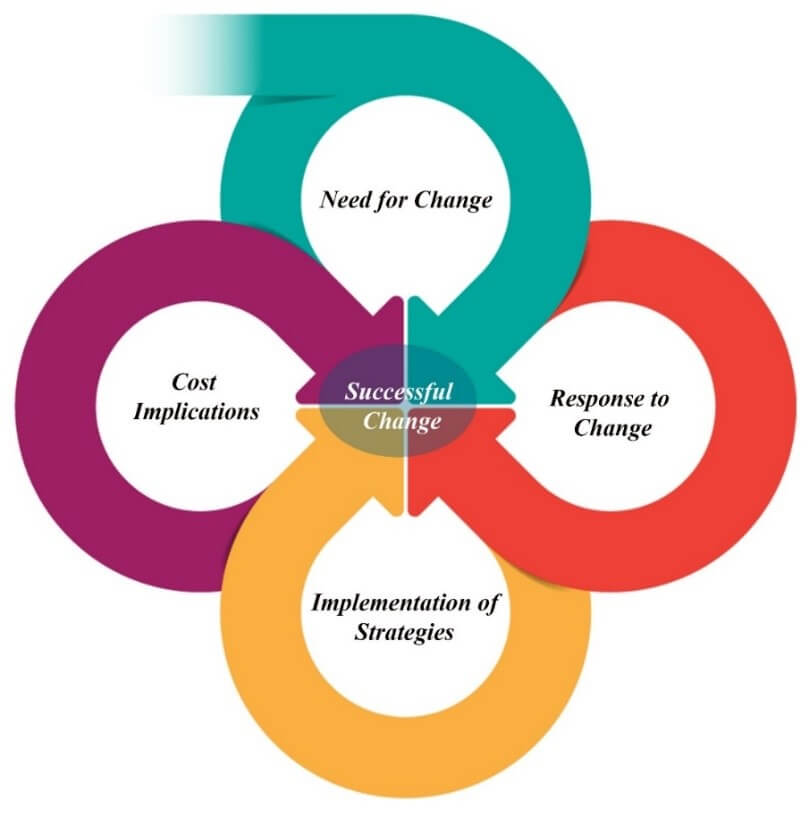
Figure 1: Overview of model components
Sub-system 1: Need for Change
Change is healthy for a project in the rapidly changing environment. It is necessary to treat the change positively with a defined plan, and good leadership is required for the successful change.
The driving factors for change are technology improvements, development of competitive businesses, and market conditions. Moreover, the change could be initiated by these advancements in the environment and also by word of mouth from other stakeholders.
Sub-system 2: Response to Change
As stated earlier, the resistance towards a change increases and the main factor which drives the resistance is fear. The employees are more concerned about job security, change in routine works, the capacity to adapt, and lack of confidence and thus, this develops as fear within the employees.
Employee who resist require time to accept the change and it is possible by developing and executing strategic programs. Moreover, the time consumed might differ based on employees’ experience. Therefore, this will help to analyse the employees’ thoughts.
Sub-system 3: Implementation of Strategies
The successful management of change resistance should include the development of common vision, communication plan, training plan, and alignment of change to an organisation’s structure.
The project manager who leads the team needs to have good leadership and decision-making qualities. These qualities will help to lead the team along the aligned path and creates a positive atmosphere for change.
Moreover, a key focus is given to implementing the strategies successfully such as continuous and effective training provided to the employees, and one on one engagement where information is shared and issues are resolved.
It is important to provide a change plan with associated risks and benefits to the employees to create transparency in the process and also provide employees with a clear scope of change.
The most important thing is to create transparency among the stakeholders and employees about the process, but complete transparency might affect the process negatively. For that reason, 50% transparency will help to successfully implement the change and avoid possible risks in the process.
Therefore, all these practices will eventually help the employees to respond positively towards the change and thus, increase the acceptance rate and productivity rate.
Sub-system 4: Cost Implications
Initiating new development will increase the cost and revising the cost plan is necessary for a project to have a clear picture of the future state.
The cost will be increased due to various factors such as hiring new experts, new training programs and sometimes, it depends on the knowledge level of an individual. The formulation of a new cost plan is significant when initiating new change and it is prepared based on new strategies developed.
Systems Dynamics: Resisting Change
An SD model (see Figure 2) is developed for the 1-year duration (12months). The input parameters included in the model will vary based on the size of the company and the project undertaken.
Thus, for the successful implementation of change, it is important to have clear change objectives, the acceptance of employees and stakeholders, their productivity towards the process and a related cost plan.
Understanding the four sub-systems and their interdependencies in the system will help to manage the change resistance effectively and implement the change process successfully.
The proposed model involves the analysis of people involved in the process and managing strategies, which makes the model distinctive from other models.
This helps to break down the management working structure and quantify the risk of a project as early as possible and how the percentage of risk can be reduced. It also helps to depict the future scenario of the project level.
This model will help to analyse the change resistance during the initiation phase of any project and provides a detailed management plan to deal the resistance to a greater extent.
This analysis could form a base for formulating stakeholder management and risks management during the project initiation phase. This model is flexible and input parameters can be changed depending upon the size and complexity of the project.
The model could be adapted for any project consists of unknowns and projects with high uncertainties.
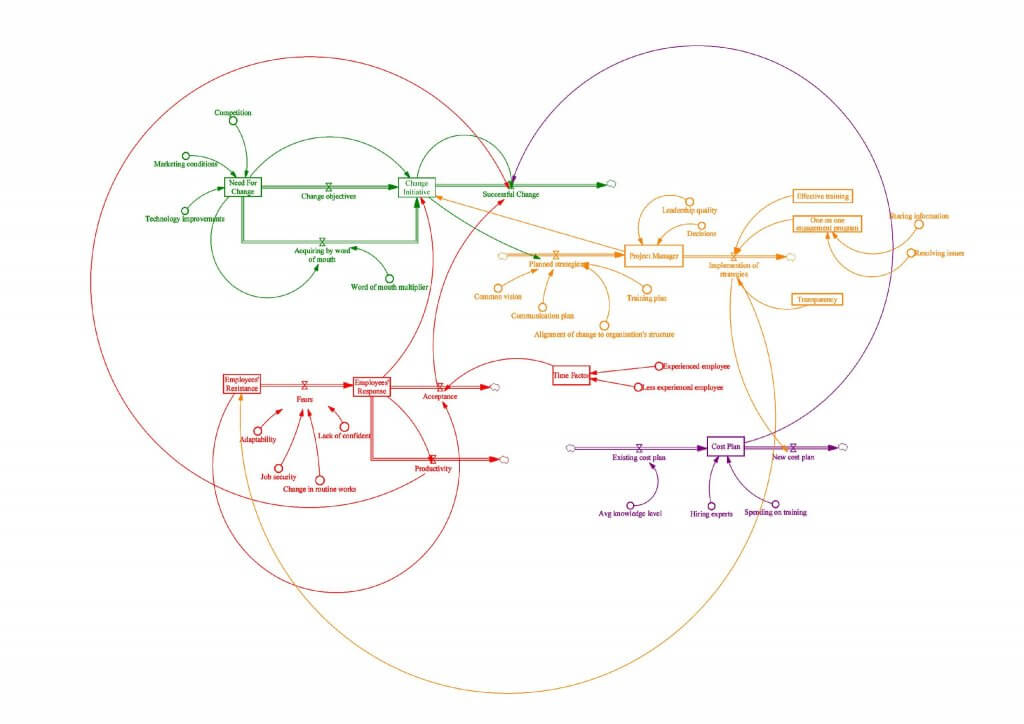
System dynamics model for change resistance
Systems Dynamics: Modelling Behaviour
Hypothetical values are used for simulation and the model is constructed to produce information for one year. This is obviously a prototype model, but the purpose here is to show the application of SD to solving complex problems. The following outcomes were found.
Need for Change
Figure 3 (Need for Change) shows the percentage of need for change with respect to duration.
It is evident that initially, the percentage of need for change increases in a project, but later, it maintains the same level because if the necessity of change in a project increases continuously then the project will continue without having a completion date.
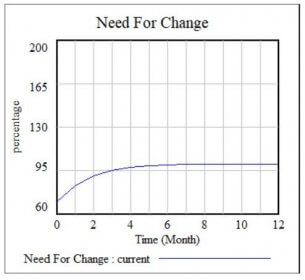
Response to Change
Figure 4 (Employees’ Resistance) displays the percentage of employees’ resistance in a project with respect to duration and it is clearly seen that resistance is reduced to a certain extent due to the successful implementation of strategies developed by a project manager.
Resistors cannot be eliminated completely and developed strategies need to be followed constantly to proceed with the new initiation to reach desired outcomes.
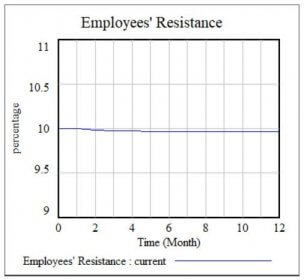
Implementation of Strategies
Figure 5 (Project Manager) shows the productivity of a project manager with respect to duration.
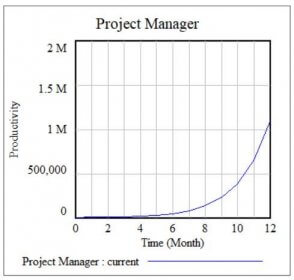
Figure 6 (Implementation of Strategies) depicts the performance of the developed strategies with respect to time.
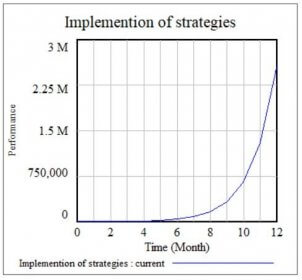
In today’s environment, it is necessary to be more productive in achieving the preferred goals. So, it is evident from Figure 5 that to deal with the resistance and to implement the change, the productivity of the project manager is increasing dramatically.
From Figure 6, the performance of the developed strategies including engagement programs, and training session doubles because it is very important to perform at a greater extent to overcome the resistance, and the process of engaging people through these activities should be continuous to provide constant support for the change implementation.
Acceptance and productivity of the employees are both important factors in the positive change process and need to be managed well to ensure successful implementation of strategies.
Figure 7 (Acceptance) illustrates the percentage of employees who accept the change process with respect to time.
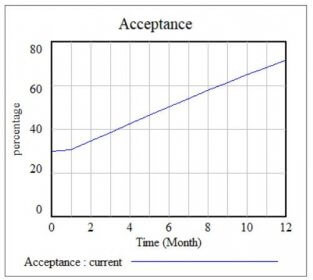
Figure 8 (Productivity) shows how productive the employees need to be in executing the process.
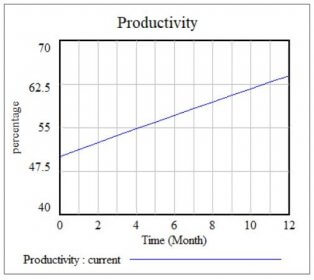
The acceptance and productivity of the employees are increasing gradually, creating a positive impact, which it is evident from both charts.
It is also found from the simulation that the productivity of the employees is twice the acceptance rate, so the employees are required to be more productive in their work than usual to successfully implement the change. This, of course, suggests other factors might be at play (like stress and overtime).
Cost Implications
Figure 9 (Cost Plan) describes the cost plan for the change initiation with respect to duration and it needs to be added to the overall project cost, and the cost is increasing because of continuous functioning of programs for the employees.
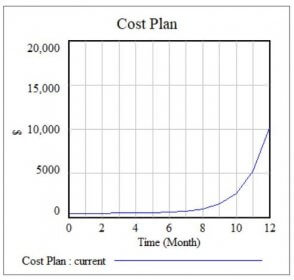
Figure 10 (Successful Change) shows the effectiveness of successful change with respect to time and it increases gradually creating a positive impact on the project to achieve desirable outcomes.
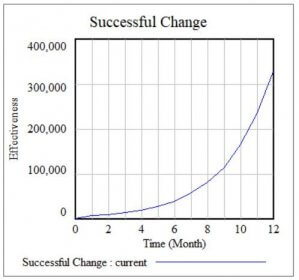
Applying this approach yields other influential benefits as well: it builds trust and respect among the employees, develops a positive atmosphere, and helps to continuously tract the process which is more important for implementing the change.
__________
Adopting this proposed SD model will help to manage the change resistance effectively and enhance the project management practice in the rapidly changing world.
Step outside the box! If you would like a copy of the SD model, please email the author.
Anushya Ravi Master of Project Management (Professional) student, Bond University, Australia.
Email: anushya.ravi@student.bond.edu.au




